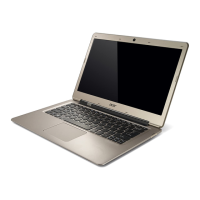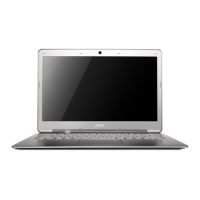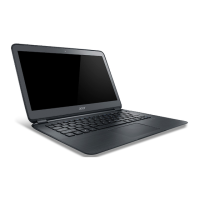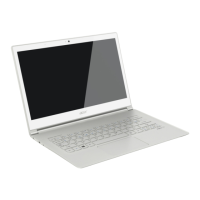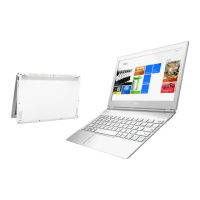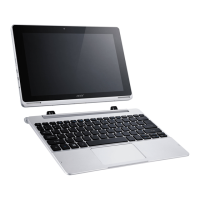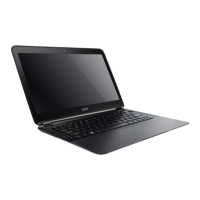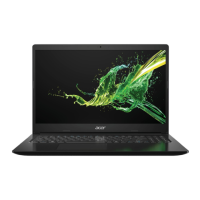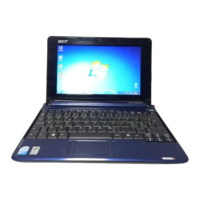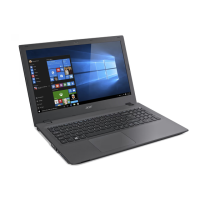Do you have a question about the Acer Aspire S3-951 and is the answer not in the manual?
General safety guidelines, product handling, and warnings for safe operation.
Guidelines for connecting, disconnecting, and using the power cord and electrical outlets safely.
Recommendations to prevent hearing loss from prolonged use of headphones at high volumes.
Precautions against water, heat, vibration, dust, and keeping small parts away from children.
Instructions for professional servicing and safe usage guidelines for lithium-ion/polymer batteries.
Details on potential interference from wireless devices and battery interactions.
Guidelines for using the device near medical equipment and pacemakers to avoid interference.
Safety advice for using the computer in vehicles and hazardous atmospheric conditions.
Information on making emergency calls and proper disposal of electronic waste.
Explanation of Acer's ENERGY STAR qualified products and their energy efficiency.
Advice for comfortable computer use, posture, and preventing eyestrain.
Recommendations for productive and healthy computer usage habits.
Introduction to the available guides that help users understand and operate their new notebook.
Essential tips for maintaining the computer, AC adapter, and performing cleaning procedures.
Instructions on how to turn the computer on, shut it down, or put it into Sleep mode.
Locating and identifying the main components visible on the top surface of the notebook.
Description of ports and connectors found on the rear, left, and right sides of the notebook.
Locating and identifying components situated on the bottom surface of the notebook.
How to use the touchpad for cursor movement, clicks, and context menus.
Explanation of Caps Lock, Num Lock, Scroll Lock, and the embedded numeric keypad.
Description of special key combinations (hotkeys) for various system functions like display and sound.
Explanation of the functionality of the Windows key and the Application key.
Introduction to the system recovery software and its backup and restore capabilities.
Step-by-step guide for creating system recovery discs or USB drives for backup.
Methods for recovering the system, including factory resets and restoring from backups.
Explanation of supported media content types and Digital Media Server (DMS) devices.
How to display, send, search media, and configure media sharing settings.
Information on the instant wake-up feature and power-saving capabilities.
Details on battery technology, charging procedures, and charge-in-use support.
Procedure for conditioning new batteries and tips to maximize battery lifespan.
How to check battery level and recommended actions for low battery warnings.
Steps to detach accessories and tips for moving the computer between locations.
Procedures for preparing the notebook for travel to offices or different buildings.
Guidelines for packing and securing the computer for travel between office and home.
Advice for protecting the computer during travel and setting up a functional home workspace.
Advice for traveling internationally, including power compatibility and connectivity.
Overview of Supervisor, User, and Password on Boot security options for computer protection.
Procedures for entering passwords when prompted by the system during boot or operation.
Instructions for connecting to the internet using available wireless networks.
Information on the feature that enhances connection speed to frequently used networks.
Explanation of wireless LAN, its advantages, and essential components for setup.
Details on using the HDMI port for connecting high-end audio and video equipment.
Explanation of the USB 2.0 port for connecting various high-speed peripherals.
How to access the BIOS utility and overview of its main configuration options.
Procedures for setting the boot order and enabling disk-to-disk recovery.
Steps to set up Supervisor and User passwords for system boot security.
Solutions for problems related to powering on, booting, and screen display issues.
Troubleshooting steps for resolving no audio problems and ejecting the optical drive.
Addressing issues with non-responsive keyboards and printer connectivity.
Restoring the system to factory settings and procedures for requesting technical support.
Guidance on how to approach and diagnose common system problems.
A list of common error messages encountered and their recommended corrective actions.
Notices regarding FCC regulations, shielded cables, and peripheral device compliance.
Details on LCD pixel specifications and general radio device regulatory compliance.
Information on EU conformity, wireless channel specifics, and French frequency band restrictions.
List of national codes for equipment operation and Canadian RF exposure guidelines.
Canadian compliance for wireless devices and FCC radio frequency safety limits.
| Graphics | Intel HD Graphics 3000 |
|---|---|
| Operating System | Windows 7 Home Premium |
| Battery | 4-cell Li-ion, up to 6 hours |
| Processor | Intel Core i5-2467M |
| RAM | 4GB DDR3 |
| Display | 13.3 inches, 1366 x 768 pixels |
| Wireless | Wi-Fi 802.11 b/g/n |
| Ports | HDMI, Headphone/Microphone combo jack |
| Dimensions | 323 x 218.5 x 13.1 mm (12.72 x 8.6 x 0.52 in) |

